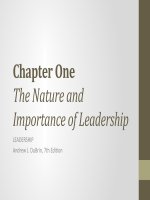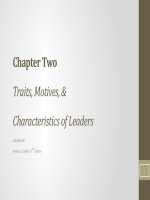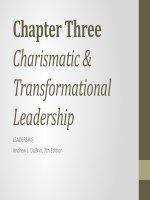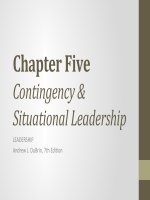Chapter 11 leadership research findings practice and skills 7th edition
Bạn đang xem bản rút gọn của tài liệu. Xem và tải ngay bản đầy đủ của tài liệu tại đây (607.2 KB, 12 trang )
Chapter Eleven
Creativity, Innovation,
and Leadership
LEADERSHIP
Andrew J. DuBrin, 7th Edition
Learning Objectives
• Identify the steps in the creative process.
• Identify characteristics of creative problem solvers.
• Be prepared to overcome traditional thinking in order to
become more creative.
• Describe both organizational and individual approaches to
enhance creative problem solving.
• Explain how the leader and the organization can establish a
climate that fosters creativity.
• Identify several leadership practices that contribute to
organizational innovation.
Creativity and Innovation
• Creativity is the production of novel and useful
ideas.
• Innovation refers to the creation of new ideas and
their implementation.
• Organizational Creativity is the creation of a
valuable, useful new product, service, idea,
procedure, or process by individuals working
together in a complex social system.
Steps in the Creative Process
Characteristics of Creative
Leaders
• KNOWLEDGE
• Knowledgeable about a wide range of information
• COGNITIVE ABILITIES
• Highly intelligent
• Intellectually curious
• Able to think divergently
• PERSONALITY
• Nonconformist
• Self-confident
• Thrill-seeking
• Energetic
• Persistent
• PASSION FOR THE TASK AND THE EXPERIENCE OF FLOW
Overcoming Traditional
Thinking as a Creative Strategy
• Creative problem solving requires an ability to overcome
traditional thinking.
• Traditional thinking generally refers to a standard and
frequent way of finding a solution to a problem.
• Central task in becoming creative is to break down rigid
thinking that blocks new ideas.
• “Thinking outside the box”
• Do keep in mind, however, that group members need to know
just how far they can venture from routine thinking.
• Effective leaders establish parameters; even for their creative thinkers.
Organizational Methods to
Enhance Creativity
• Systematically Collecting Fresh Ideas
• Employees furnish ideas into a company database
• Brainstorming
• Generate Quantity – Avoid Criticism – Combine and Improve on Previous
Ideas – Combine and Improve on Previous Ideas
• Using the Pet-Peeve Technique
• Identifying all potential complaints from anyone who interacts with the
group
• Value comes from helping group improve its work processes
• Equipping a Kitchen for the Mind
• Allocating and stocking a specific space designed to nurture creativity –
“a creativity room”
Self-Help Techniques to Enhance
Creative Problem Solving
• Practicing creativity-enhancing activities
• Staying alert to opportunities
• Maintaining an enthusiastic attitude, including
being happy
• Maintaining and using a systematic place for
recording your ideas
• Playing the roles of explorer, artist, judge, and
lawyer
• Engaging in appropriate physical exercise
Establishing a Climate and
Culture for Creative Thinking
Leadership Practices for Enhancing Creativity
• Hire creative people from the outside and identify creative people from
within
• Intellectual challenge
• Empowerment including freedom to choose the method
• Ample supply of the right resources
• Effective design of work groups
• Supervisory encouragement and linking innovation to performance
• Organizational support
• Have favorable exchanges with creative workers
• Give financial rewards for innovation
Establishing a Climate and
Culture for Creative Thinking
Methods of Managing Creative Workers
• Give creative people tools and resources that allow
their work to stand out.
• Give creative people flexibility and a minimum amount
of structure.
• Give gentle feedback when turning down an idea.
• Employ creative people to manage and evaluate
creative workers.
Additional Leadership Practices
That Enhance Innovation
• Emphasize transformational leadership if possible.
• Continually pursue innovation.
• Take risks and encourage risk taking.
• Emphasize collaboration among employees.
• Avoid innovation for its own sake.
• Use loose-tight leadership.
• Integrate development and production.
• Recognize the hidden opportunities when products
and ideas flop.
Summary
• A creative leader brings forth ideas for things that did not exist
previously.
• The creative process involves five steps: opportunity or problem
recognition, immersion, incubation, insight, and verification and
application.
• Having the right characteristics improves the chances of a person being
a creative problem solver and a creative leader.
• Creativity requires overcoming traditional thinking.
• Creative thinking can be enhanced by systematically collecting fresh
ideas and brainstorming.
• Generating creative ideas has moral implications.
• Establishing a climate conducive to creative problem solving is a
requirement of effective leadership.









